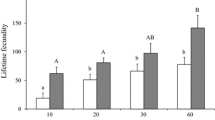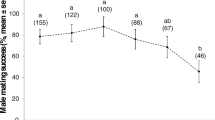Abstract
To examine how traumatic insemination, a wounding process to females inflicted by males during copulation, reduces the longevity of females of the bedbug, Cimex lectularius, we assessed if multiple bouts of mating impact water relations of females by measuring net transpiration water loss rates. Our studies show that net transpiration rate of females correlates with frequency of mating (small increase after exposure to low numbers of males; large increase after exposure to large numbers of males), and this is reflected by reduced female survivorship for as much as 22 days at 75% RH, 25°C. Water loss occurs up to 28% more rapidly in females after being held with large groups of males. Females that were exposed to males having their paramere removed, females exposed only to other females, and females kept in isolation (unmated) exhibited no reduction in ability to retain water, indicating that traumatic insemination was responsible for the net transpiration rate increase. Mechanical piercing of the female’s abdominal wall leads to increased net transpiration rates for longer periods than puncturing the ectospermalege (regular mating site), implying that inaccurate copulation by males is extremely detrimental to the water balance of females and that the ectospermalege is uniquely modified to seal off more quickly to prevent excess water loss. Mating frequency and the associated increased water loss is considerably reduced by the addition of bed bug alarm pheromone components. Thus, females experience elevated water stress due to traumatic insemination, especially at high levels and when males fail to pierce the ectospermalege, and water loss prevention, likely by more rapid sealing of the wound, is a novel function of the ectopsermalege.




Similar content being viewed by others
References
Allan SA, Patrican LA (1994) Susceptibility of immature Ixodes scapularis (Acari: Ixodidae) to desiccants and an insecticidal soap. Exp Appl Acarol 18:691–702
Appel AG, Moar WJ, Tanley MJ (1999) Water loss and mortality of adult cowpea weevils (Coleoptera: Bruchidae) exposed to desiccants and desiccating environments. Environ Entomol 28:979–982
Arlian LG, Vyszenski-Moher DL (1995) Responses of Sarcoptes scabiei var. canis (Acari: Sarcoptidae) to lipids of mammalian skin. J Med Entomol 32:34–41
Benoit JB (2011) Stress tolerance of bed bugs: a review of factors that cause trauma to Cimex lectularius and C. hemipterus. Insects 2:151–172
Benoit JB, Denlinger DL (2010) Meeting the on- and off-host challenges of water balance in blood feeding arthropods. J Insect Physiol 56:1366–1376
Benoit JB, Yoder JA, Rellinger EJ, Ark JT, Keeney GD (2005) Prolonged maintenance of water balance by adult females of the American spider beetle, Mezium affine Boieldieu, in the absence of food and water resources. J Insect Physiol 51:565–573
Benoit JB, Del Gross NA, Yoder JA, Denlinger DL (2007) Resistance to dehydration between bouts of blood feeding in the bed bug, Cimex lectularius, is enhanced by water conservation, aggregation and quiescence. Am J Trop Med Hyg 76:987–993
Benoit JB, Philips SA, Croxall TJ, Christensen BS, Yoder JA, Denlinger DL (2009) The addition of alarm pheromone components improves the effectiveness of desiccant dust against the bed bug, Cimex lectularius. J Med Entomol 46:572–579
Benoit JB, Desai K, Hardesty JJ, Patrick KR, Krause TB, Denlinger DL (2010) Repeated bouts of dehydration deplete nutrient reserves and reduce egg production in the mosquito. J Exp Biol 213:2763–2769
Edney EC (1977) Water Balance of Land Arthropods. Springer, Berlin
Ferng SF, Lee LW (2002) Indoor air quality assessment of daycare facilities with carbon dioxide, temperature, and humidity as indicators. J Environ Health 65:14–18
Hadley NF (1994) Water relations of terrestrial arthropods. Academic, New York
Harraca V, Ryne C, Ignell R (2010) Nymphs of the common bed bug (Cimex lectularius) produce anti-aphrodisiac defence against conspecific males. BMC Biol 8:121
Levinson HZ, Bar Ilan AR (1970) Assembling and alerting scents produced by the bed bug Cimex lectularius L. Experientia 27:102–103
Levinson HZ, Levinson AR, Müller B, Steinbrecht RA (1974) Structure of sensilla, olfactory perception, and behavior of the bedbug, Cimex lectularius, in response to its alarm pheromone. J Insect Physiol 20:1231–1248
Montes C, Cuadrillero C, Vilella D (2002) Maintenance of a laboratory colony of Cimex lectularius (Hemiptera: Cimicidae) using an artificial feeding technique. J Med Entomol 39:675–679
Morrow EH, Arnqvist G (2003) Costly traumatic insemination and a female counter-adaptation in bed bugs. Proc R Soc Lond B 270:2377–2381
Nation JL (2001) Insect physiology and biochemistry. CRC, Boca Raton
Polanco AM, Miller DM, Brewster CC (2011) Reproductive potential of field-collected populations of Cimex lectularius L. and the cost of traumatic insemination. Insects 2:326–335
Reinhardt K, Siva-Jothy MT (2007) Biology of the bed bugs (Cimicidae). Ann Rev Entomol 52:351–374
Reinhardt K, Naylor R, Siva-Jothy M (2003) Reducing a cost of traumatic insemination: female bed bugs evolve a unique organ. Proc Roy Soc Lond B 270:2371–2378
Reinhardt K, Naylor RA, Siva-Jothy MT (2009a) Situation exploitation: higher male mating success when female resistance is reduced by feeding. Evolution 63:2–39
Reinhardt K, Naylor RA, Siva-Jothy MT (2009b) Ejaculate components delay reproductive senescence while elevating female reproductive rate in an insect. Proc Nat Acad Sci 106:21743–21747
Reinikainen LM, Jaakkola JJ, Seppanen O (1992) The effect of air humidification on symptoms and perception of indoor air quality in office workers: a six-period cross-over trial. Arch Environl Health 1:8–15
Ryne C (2009) Homosexual interactions in bed bugs: alarm pheromones as male recognition signals. Anim Behav 78:1471–1475
Sokal RR, Rohlf FJ (1995) Biometry: the principles and practice of statistics in biological research, 3rd edn. Freeman, San Francisco
Stutt AD, Siva-Jothy MT (2001) Traumatic insemination and sexual conflict in the bed bug Cimex lectularius. Proc Nat Acad Sci 98:5683–5687
Toolson EC (1978) Diffusion of water through the arthropod cuticle: thermodynamic consideration of the transition phenomenon. J Therm Biol 3:69–73
Usinger RL (1966) Monograph of Cimicidae, vol 7. Thomas Say Foundation, Entomological Society of America, College Park
Wharton GW (1985) Water balance of insects. In: Kerkut GA, Gilbert LI (eds) Comprehensive insect physiology, biochemistry, and pharmacology, vol 4. Pergamon, Oxford, pp 565–603
Winston PW, Bates DS (1960) Saturated salt solutions for the control of humidity in biological research. Ecology 41:232–237
Author information
Authors and Affiliations
Corresponding author
Additional information
Communicated by I.D. Hume.
Rights and permissions
About this article
Cite this article
Benoit, J.B., Jajack, A.J. & Yoder, J.A. Multiple traumatic insemination events reduce the ability of bed bug females to maintain water balance. J Comp Physiol B 182, 189–198 (2012). https://doi.org/10.1007/s00360-011-0607-x
Received:
Revised:
Accepted:
Published:
Issue Date:
DOI: https://doi.org/10.1007/s00360-011-0607-x




